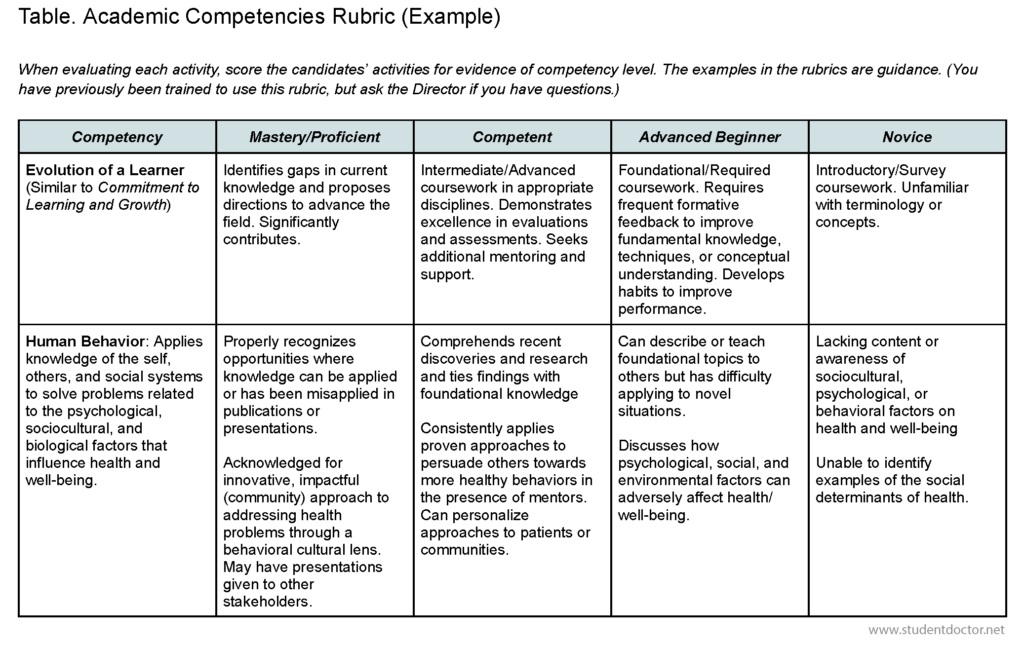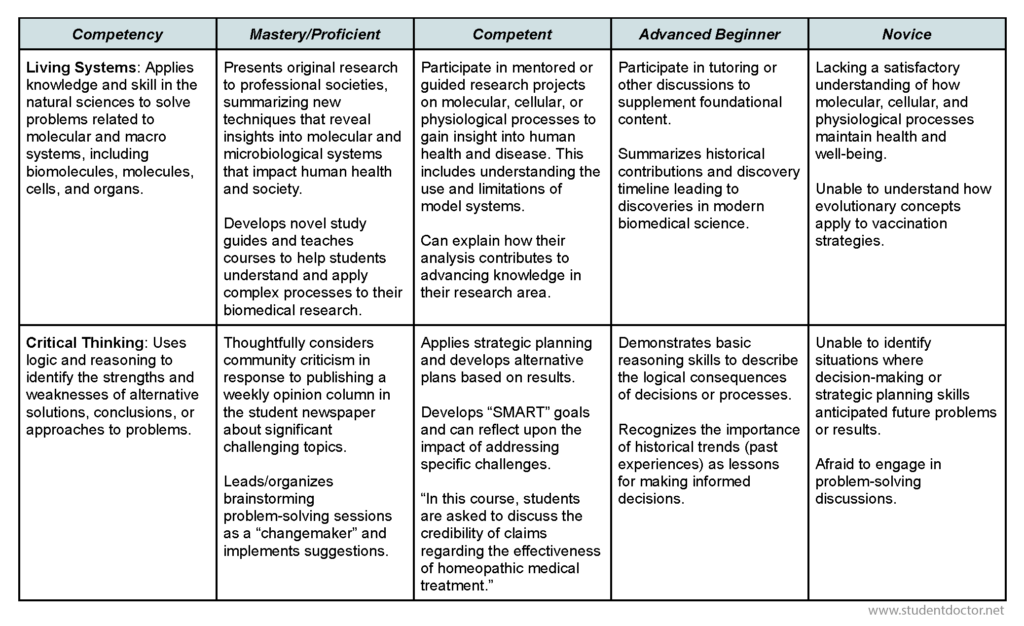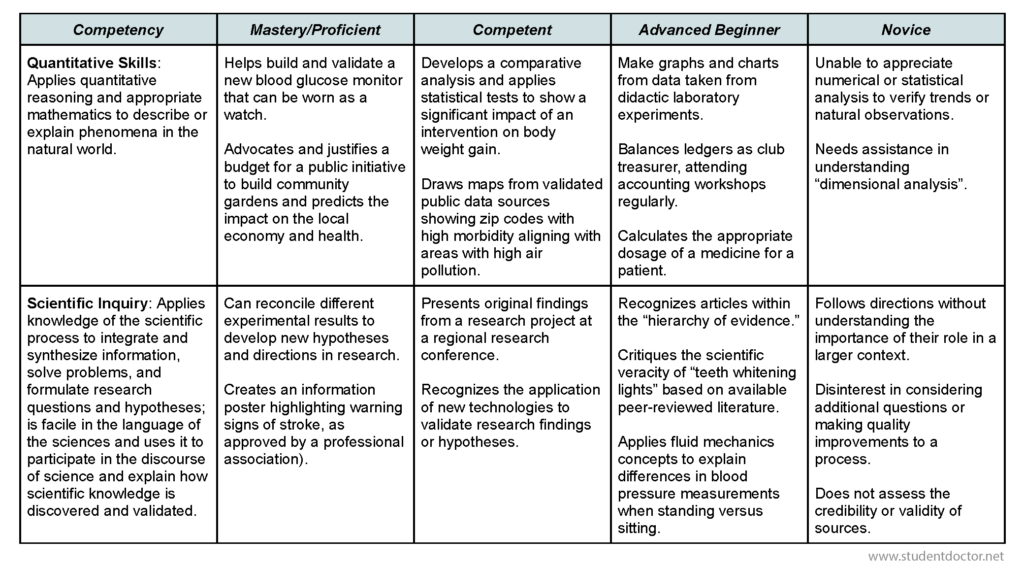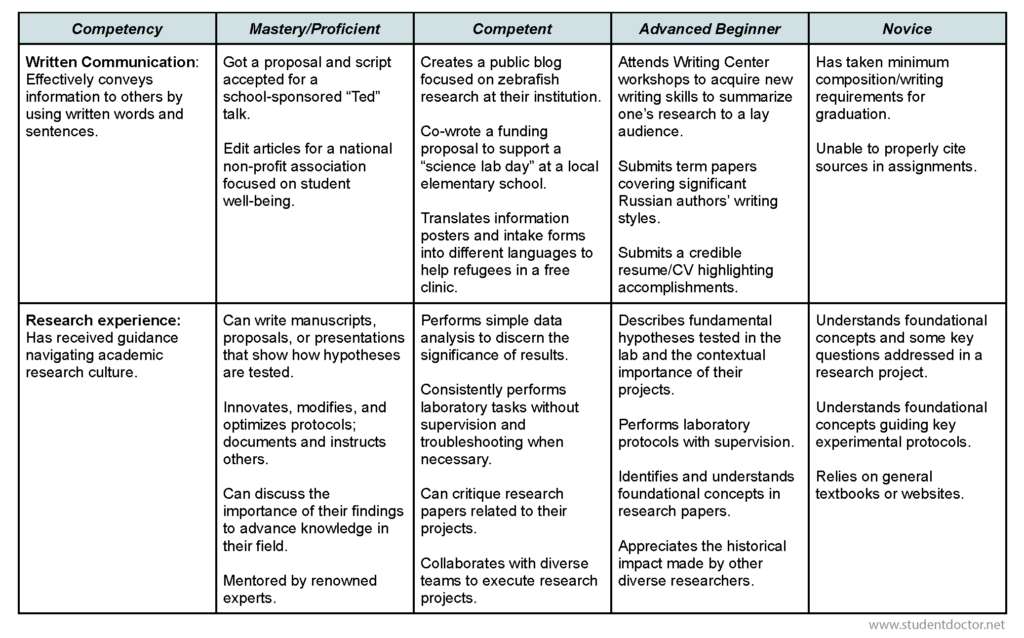Last Updated on April 17, 2025 by Laura Turner
Over a decade ago, I wrote a series of articles (here is Part 1) that heralded the growing importance of understanding “competency.” Over the last decade, I developed rubrics for academic and pre-professional competencies to guide prehealth advisors and help admissions screeners to select applicants for interviews.
With the 2023 revision of the AAMC Premed Competencies, I felt it important to revisit these concepts with a new generation of applicants, especially the post-pandemic (Generation P) applicants applying in the 2020s decade. While these changes should not impact how applications are evaluated, prehealth advising offices are adjusting their evaluations to address how you demonstrate these competencies (and others) in their letters of recommendation/evaluation.
This article will show how you can frame your competency development from information on your application, just like your prehealth advisors and application reviewers, using the new competency definitions.
AAMC Anatomy of an Applicant
Many prehealth advisors encourage aspiring applicants (including pre-dental and pre-veterinary students) to complete the AAMC “Anatomy of an Applicant” guide, which addresses the Premed Competencies. Students consider how specific activities helped them gain confidence in their competency development and find their voice if an activity is personally meaningful. Additional testimonials help applicants see how medical students describe their activities and accomplishments with an eye toward the Premedical Competencies evaluators seek.
The Six Academic Competencies
Desired in all prehealth fields, the six “academic competencies” encompass foundational content, critical thinking, and analysis skills.
Science Competencies
- Human Behavior: Applies knowledge of the self, others, and social systems to solve problems related to the psychological, sociocultural, and biological factors that influence health and well-being.
- Living Systems: Applies knowledge and skill in the natural sciences to solve problems related to molecular and macro systems, including biomolecules, molecules, cells, and organs.
Thinking and Reasoning Competencies
- Critical Thinking: Uses logic and reasoning to identify the strengths and weaknesses of alternative solutions, conclusions, or approaches to problems.
- Quantitative Skills: Applies quantitative reasoning and appropriate mathematics to describe or explain phenomena in the natural world.
- Scientific Inquiry: Applies knowledge of the scientific process to integrate and synthesize information, solve problems, and formulate research questions and hypotheses; is facile in the language of the sciences and uses it to participate in the discourse of science and explain how scientific knowledge is discovered and validated.
- Written Communication: Effectively conveys information to others by using written words and sentences.
Most presume that grades on a transcript best demonstrate these competencies on a transcript; a 4.00 GPA should prove one has the highest possible mastery of these competencies. Further proof comes from high scores on standardized exams like the MCAT, DAT, or OAT, designed to test one’s Thinking and Reasoning Competencies. However, screeners want to be sure future students have evidence of understanding these competencies.
With Competency Comes Trust
Throughout health professions education, student promotion is based on demonstrating professional competency by assuring their faculty, evaluators, and peers that they can perform their duties to the expected standards. Residents progress in their training by showing their ability to complete “entrustable professional activities” (EPAs) consistently and without intense supervision, and each EPA encompasses several competencies. Being re-hired as a more senior resident or being selected as chief depends on how your preceptors rate you on these EPAs.
Veterinary medicine fully embraced competency-based education and developed an extensive resource identifying key EPAs and milestones each veterinary student should progressively complete to demonstrate professional competency and (relative) independence.
Each activity highlighted in an application similarly addresses more than one competency, so you should focus on the key competencies you feel were best developed during each experience. Because gaining competency takes time, those activities in which one has invested hundreds of hours of experience are most informative about competencies gained. To that end, the activities where you have placed most of your focus (hours completed) are what we target when we apply our competency evaluation rubrics.
Let’s look at how a research activity could be viewed from a competency perspective.
Ari, Billie, and Cam have worked in Professor Beaker’s cancer biology lab group. Ari is learning how to extract and digest DNA for sequencing. Ari works beside Billie, who has been making the primers for sequencing and providing Professor Beaker with weekly updates on the progress of the experiments. Responsible for ensuring the lab is kept clean, Cam prepares a proposal for a thesis, provides feedback to Billie’s reports before they are sent to Dr. Beaker, and summarizes articles that could inform Billie’s and Dr. Beaker’s hypotheses. Cam also helps Dr. Beaker develop graphs and figures for his grant proposals.
What would you expect Professor Beaker to say about Ari, Billie, and Cam if they applied this upcoming cycle to a health professional or graduate program? The rubrics were created to help evaluators communicate an applicant’s competency development with application reviewers. Table 1 shows a sample rubric focused on the academic competencies.
Ari can also use the rubric to describe their role in the research lab. They should be able to describe Professor Beaker’s area of research expertise, current responsibilities, and benefits from participating in the lab.
Billie can mention their responsibilities, from being trusted with running a key protocol for the lab to specific opportunities to troubleshoot or validate quality control of the results. Achieving such trust is gained from repeated demonstrations of consistent, satisfactory performance.
Cam understands the importance of more than one protocol in the lab. Keeping the laboratory appropriately clean ensures everyone’s experiments are run at a high standard. Cam can also focus on larger-picture perspectives needed to submit a thesis proposal and develop critical data figures, which Professor Beaker can attest to in a letter of recommendation/evaluation.
Using the context of the research lab’s pursuit of knowledge (in Living Systems), Professor Beaker can evaluate each person’s Critical Thinking, Quantitative Skills, Scientific Inquiry, and Written Communication through their approach to their experiments and projects.
A common mnemonic summarizes competency attainment in four words: “Listen, See, Do, Teach.” Learners become Masters through this evolution, whether taking patient histories and physicals or inserting an intravenous line. Supervisors confer greater trust and confidence in the learner as they build competency with repeated, consistent excellence.
When describing your experiences, highlight how your co-workers and supervisors trusted you with your academic competencies. In the next article, we will apply this concept to describe your pre-professional competencies.
A Sample Rubric for Academic Competency
Admissions committees design their rubrics to create a preliminary shortlist of applicants for the interview phase. This example only focuses on applying the academic competencies defined by the AAMC; the descriptors do not necessarily represent the guidance screeners and reviewers receive to assess application materials or interviews.
After including applications that meet GPA or test score thresholds (minimum or desirable), screeners review applications for descriptions that validate a “rating” on the rubric. Applications are then classified according to the overall impression of interview eligibility.
This rubric adds two additional criteria: the pre-professional competency Commitment to Learning and Growth is included with descriptors in academic contexts. This category considers relevant preparatory courses and an expectation to adapt to discoveries or updated standards of practice.
There is also an additional criterion for research-intensive tracks such as MD/PhD. Characteristics and competencies that suggest success and resilience should be affirmed by a letter of evaluation from their supervising research investigator. When candidates are asked about their research, this category should guide applicants about their confidence in taking on a new project and their early accomplishments as future scientists/clinicians. This rubric also summarizes the confidence of the research investigator’s evaluation in championing the applicant towards a research track.





Prehealth advisors and evaluation committees should present their assessment rubrics to students as part of their application preparation. The rubrics allow students to improve their work/activities descriptions and essays to optimize signaling their competency attainment.
Next week, I will give you a similar competency assessment rubric for the pre-professional competencies.
Get the Rubrics PDF
Please enter your email below to get a printable PDF version of the pre-professional and academic competencies rubrics sent to your email.
Endnotes
This article is an updated version of the following book chapter:
Chuck ET and Elam C (2022). Using Pre-Professional Competencies in Advising, Tracking, and Writing Letters of Evaluation. Handbook of Research on Developing Competencies for Pre-Health Professional Students, Advisors, and Programs. Ganjoo R and Schwartz LS, editors. DOI: 10.4018/978-1-6684-5969-0.ch010 Accessible at https://www.irma-international.org/viewtitle/305097/?isxn=9781668459690 .
This article is developed for the Becoming a Student Doctor resource developed by HPSA. Join the SDN forums as a Gold Member or request a scholarship for personalized advice to build a compelling mission-focused application profile.
